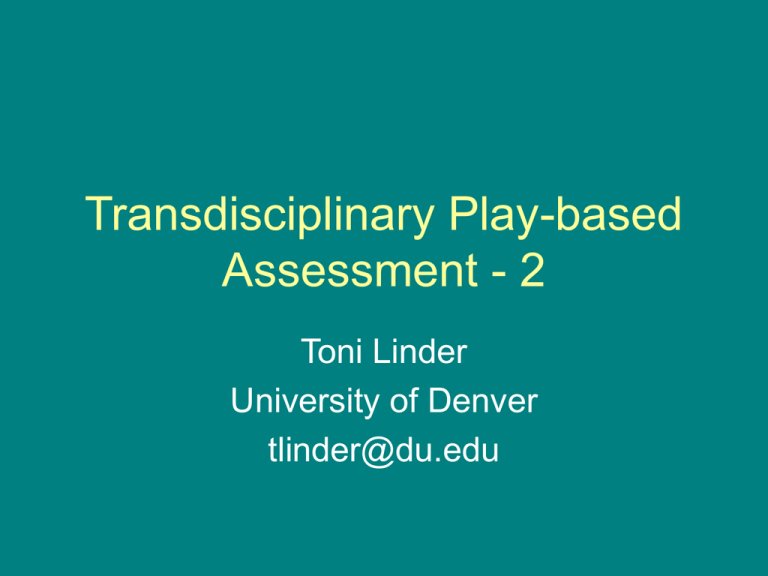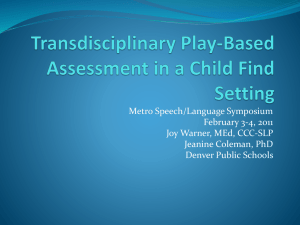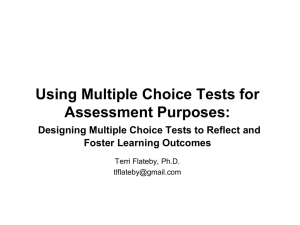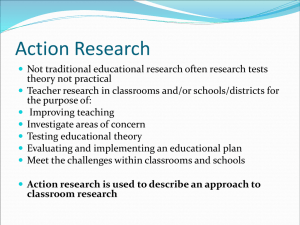Linder - TPBA no pics powerpoint
advertisement

Transdisciplinary Play-based Assessment - 2 Toni Linder University of Denver tlinder@du.edu Assessment Needs • Need for a flexible process, responsive to individual needs (Bagnato and Neisworth, 2004) • Information needed for intervention is not found in numbers and percentile scores (Meisels and Atkins-Burnett 2000) • Assessment needs to address interests and intentions as well as skills (Greenspan and Meisels, 1996; Cain and Dweck, 1995; • Assessment and intervention need to inform each other in an ongoing manner (McConnell, 2000) Problems with traditional tests • Materials in test kits are presented regardless of experiences, background, or familiarity (Neisworth & Bagnato, 2004) Problems with traditional tests • Advantage goes to the advantaged and the culture of standardization (Hanson & Lynch, 1992) • Standardized language may present an obstacle (Meisels, 1996) Problems.. • Traditional tests measure what has been learned, not what can be learned (Butler, 1997) Problems…. • Isolated assessment of discrete domains, such as “language” or “cognition,” often yields fractional, inadequate, misleading, or incomplete information. Problem: “Untestable” children • Bagnato & Neisworth (1994) when child is “untestable” - 58% parent interviews - 44% play-based assessment - 30% observation of natural parentchild interaction Problem Summary • “Assessment of infants and preschoolers remains dominated by restrictive methods and styles that place a premium on inauthentic, contrived developmental tasks, that are administered by various professionals in separate sessions using small, unmotivating toys from boxes or test kits, staged at a table or on the floor in an unnatural setting, observed passively by parents, interpreted by norms based solely on typical children, and used for narrow purposes of classification and eligibility determination” (Bagnato, Neisworth & Munson, 1997, p. 69). Changes needed…. • 1) What constitutes an assessment, • 2) What questions assessment of young children should examine, • 3) What methods should be used to answer these questions, Changes needed… • 4) Who should be involved in gathering assessment data, • 5) What the outcomes of an assessment should look like, and, • 6) How assessment information should be used (Eisert, & Lamorey, 1996; Meisels & Atkins-Burnett, 2000; Meltzer & Reid, 1994). Needed… • Assessment needs to be viewed as a process not just a tool Eight critical qualities… • 1) useful, providing a linkage between assessment results and intervention goals, objectives, and strategies; • 2) acceptable, providing information that is mutually relevant to professionals and families; Eight critical qualities • 3) authentic, providing information that describes how children function in their natural environments; • 4) collaborative, involving professionals and parents in a partnership beginning before assessment and through intervention; Eight critical qualities • 7) sensitive, providing incremental developmental sequences and observations that can differentiate small increments of progress; • 8) congruent, using content, materials, and methods that match the developmental levels and individual differences of children Benefits of TPBA - 2 • • • • Dynamic Functional Flexible Sensitive to child and family differences Benefits of TPBA - 2 Results in quantitative and qualitative information related to: • Skill level • Learning style • Interaction patterns • Contexts for development • Intervention objectives and strategies Benefits of TPBA - 2 • Natural processes such as play result in less inhibited interactions, and consequently higher levels of communication, more exploration, and increased attention and problemsolving (Meisels & Atkins-Burnett, 2002) • Play is consistent with interests and needs of young children Benefits of TPBA - 2 • A convergent assessment model –Caregivers’ observations –Professionals observations –Additional testing if needed Information from caregivers • Developmental, social, and health history • Routines, values • Current skills and behaviors • Contexts • Favorite toys and materials Instruments • Child and Family History Questionnaire (CFHQ) • Family Assessment of Child Functioning (FACF) Observations of child: interactions • With caregivers • With siblings • With peers • With adults Benefits of TPBA - 2 • Non-directive, informal, synchronous interactions, rather than questionand-answer formats result in increased initiations and communication on the part of the child (Grisham-Brown, 2000). • More accurate picture TPBA - 2 Process Involves • Observing the child’s spontaneous behaviors • Encouraging turn-taking through imitation • Responding to the child at a developmentally appropriate level TPBA -2 Process Involves • Facilitating higher levels of performance through scaffolding, using more or less structure and reinforcement as needed TPBA Process Involves • Providing opportunities for problem-solving and creativity • Promoting social interaction and communication TPBA - 2 Process Involves • What worked during assessment? – Interaction patterns resulting in increased play and communication that can be replicated throughout the day. – Environmental modifications found to be beneficial that can be incorporated in the child’s natural environments. TPBA - 2 Collaborative team • Discipline roles • TPBA Roles • Parent/family roles TPBA - 2 Overview • • • • Obtaining Preliminary Information Conducting the assessment Analyzing the data Discussing and integrating all information • Writing the report • Follow-up TPBA - 2 Content • Sensorimotor development and vision • Emotional and social development • Language and communication development and hearing • Cognitive development TPBA - 2: Sensorimotor Domain Sub-categories • • • • • • • Functions Underlying Movement Gross Motor Ability Arm and Hand Use Motor Planning and Coordination Modulation of Sensation Motor Contributions to Self-Care Activities Vision TPBA - 2: Emotional and Social Domain Sub-categories • • • • • • • Emotional Expression Emotional Style State and Emotional Regulation Behavioral Regulation Sense of Self Emotional Themes of Play Social Relations TPBA - 2: Communication Domain Sub-categories • • • • • • • Language Comprehension Language Expression Pragmatics Articulation/Phonology Voice Fluency Hearing TPBA - 2 Cognitive Domain Sub-categories • • • • • • • Attention Memory Problem-Solving Social Cognition Complexity of Play Science and Math Concepts Emerging Literacy Specifics of TPBA - 2 Questions for planning TPBA What are the referral questions? Family concerns, priorities? What skills and behaviors do the parents report seeing at home? What risk and protective factors are evident from the Child and Family History Questionnaire that may have an impact on the TPBA, the analysis of data, or intervention needs? Are there other assessment questions of interest to the team? Observations of child: Engagement • Toys, materials: -sensory materials -manipulatives -construction toys -fine and gross motor -art materials -dramatic play -books • Routines Theme Boxes Doctor Doctor’s kit Ace bandage Eye chart Otoscope Stethoscope Doctor’s hammer Cookout/ Picnic Plates/ dishes Placemats Table cloth/blanket Frying pan Thermos/ bottle Play watermelon Grill Spatula Blocks for briquettes or sticks for fire Bakery Bowl Cake pan Measuring spoons Cupcake tins Apron Liquid & solid measuring cups Oven mitts Veterinarian Stuffed animals Doctor kit Bandages Sack of “dog food” Leash Small cage Weighing scale Animal bed Medicine bottles Rubber gloves Thermometer Real band aids/ box Blood pressure gauge Child-Caregiver Interactions • As parent feels comfortable • As child needs • Observations in play, routines, informal interactions • Child’s response when interacting, not interacting, with separation III. Problem-solving guidelines III. A. What behaviors indicate understanding of causal reasoning skills or problem-solving (executive function)? III. B. Can the child identify and plan a solution to a problem? III. C. How well is the child able to organize, monitor, and evaluate progress toward a goal and make corrections? III. D. How quickly can the child analyze a problem situation and respond? III. E. How well can the child generalize information from one situation to another? Problem-solving Strengths Has causal understanding and age appropriate problem-solving skills with o objects o people o situations o all of the above Emerging causal understanding and problem-solving skills with o objects o people o situations o all of the above Can identify age appropriate solutions to problems Knows there is a problem, but need assistance to identify a play Can organize actions toward a goal Can monitor and correct self at an age appropriate level Makes corrections with assistance Problem-solving Concerns Delayed understanding of problem Reduced problem-solving skills Reduced organization skills Reduced ability to monitor and alter plans Problem-solving: Ready For…. Try alternative actions Organize a series of actions Choose strategies based on situation Modify attempts based on based on results of actions 18 MO. * knows functions of objects (12-18 mo) * recognizes & points to body parts * uses spatial concepts , such as “up, down” (12-18 mo) * can place circle and square in puzzle * carries books around while walking (12-18 mo) * holds book open with help (12-18 mo) * gives book to adult to read (12-18 mo) * shows familiarity with the text upon seeing illustration (says some of words in text) WRITING * scribbles spontaneously (13-18 mo.) 21 MO. * Understands and uses: -agents (e.g., mama) - actions (e.g., run) - objects (e.g., cup) - recurrence (e.g., more) - cessation (e.g.., stop) - disappearance (e.g., all gone) (18-20 mo.) * matches familiar objects (e.g., picks out spoons from all silverware) * makes collections of things that are alike in some way (puts toys with wheels together) * knows location (e.g., “there”) (18-20 mo.) * nests objects (relates sizes) * puts circle, square, triangle shapes in puzzle (18 to 24 mo.) * one-to-one correspondence with two objects READING SKILLS * points to a picture and asks, “What’s that?” or indicates that a label is requested (13-20 mo) * notices print rather than just pictures, may point to labels under pictures when pictures are named (15-20 mo) * shows empathy for characters or situations depicted in books (16-20 mo) * makes associations across books WRITING SKILLS * begins to draw vertical and horizontal lines * continues to scribble 24 MO. * points to & names body parts (13-24 mo) * distinguishes living and non-living things * have knowledge of basic-level categories, such as plants, animals, and people * knows “more” (18-24 mo) * compares & matches form, size, color, (18-24 mo) READING SKILLS * enjoys a variety of interactive books (12-24 mo) * engages in reading behavior by verbalizing while looking at books (12-24 mo) * performs an action shown or mentioned in a book (12-24 mo) * sits for several minutes looking at a book (12-24 mo) * takes books off shelf and replaces them (12-24 mo) * may accidentally tear pages, decrease in intentional tearing (12-24 mo) * carries books around the house (18-24 mo) * may use book as transitional object (18-24 mo) * recites parts of well known stories, rhymes, songs (18-24 mo) * distinguishes print from non-print (18-24 mo) * identifies objects in a photograph (18-24 mo.) WRITING SKILLS * hand dominance emerges (18-24 mo.) * explores making marks with pencil or crayon (18-24 mo) * imitates vertical strokes (18-24 mo.) * imitates circular scribble (20-24 mo.) * draws zig-zags, lines, and loops during scribbling Facilitation Strategies • Following the child’s lead • Observation of spontaneous behaviors • Imitation of child • Modeling new behaviors • Turn-taking Facilitation Strategies: Verbal • Commenting –Self talk –Parallel talk • Open-ended questions • Wait time!! Facilitation Strategies: Verbal • Imitation • Modeling of sounds, words gestures, signs, sentence structure • Modeling affect Facilitation Strategies • Scaffolding with varying amount of structure and reinforcement – Gestural – Verbal – Physical – Environmental Facilitation Strategies: Environmental Modification • • • • • Positioning materials Positioning child Modifying materials Using assistive technology Modifying sensory input DISCUSSION WITH FAMILIES • What skills does the child exhibit spontaneously, without support? • What skills can be elicited with scaffolding or support? • What strategies resulted in higher levels of behavior or performance? • What abilities or difficulties are indicated? • What may be contributing to the abilities or disabilities? Analysis and Discussion • • • • • Soon after observation Review assessment questions Parent perceptions Team perceptions Summary of skills and contexts for highest skills • Translate into intervention recommendations DISCUSSION WITH FAMILIES • What skills does the child exhibit spontaneously, without support? • What skills can be elicited with scaffolding or support? • What strategies resulted in higher levels of behavior or performance? • What abilities or difficulties are indicated? • What may be contributing to the abilities or disabilities? DISCUSSION WITH FAMILIES • What follow-up is recommended if the child is not eligible for services? • What are the developmental priorities for intervention if the child is eligible for services? • What strategies are recommended for each priority? For home? For school? • What special services or activities will best meet these needs? (Where? By whom, with what intensity, for how long?) Development of Program and Intervention Plans • • • • • Identification and placement IFSP/IEP development Priorities for intervention Specific developmental objectives Intervention planning within routines and contexts of individual family • Resource problem-solving TEMPLATES FOR WRITING RECOMMENDATIONS FOR TPBA • Think: What is he or she doing now and what skills or experiences is the child ready for—and WHY? Give specific examples for home and/or school. RECOMMENDATIONS • He is currently doing…. And therefore he is ready to ….. • OR he is ready for more…. (Vertical or horizontal) • In order to develop….she will benefit from….. • Activities to encourage….include…… • Adaptation of …will allow her to….. • Stimulation of …..using….will….. Transdisciplinary Play-based Assessment Results in quantitative and qualitative information related to: • Skill level • Learning style • Interaction patterns • Contexts for development • Intervention objectives and strategies Transdisciplinary Play-based Assessment - 2 • Paul H. Brookes Publishing Co. • 1-800-638-3775 • brookespublishing.com • tlinder@du.edu • 303-871-2474 TPBA Research Summary References Traditional Validity & Ecobehavioral Validity • • • • • Content validity Concurrent validity Social validity Ethnic validity Treatment validity Research on TPBA • Interrater, test-retest reliability, concurrent validity, Friedli (1994) • Social validity, Myers, McBride, & Peterson (1996) • Interrater reliability, Al-Balhan (1998) Research on TPBA:Interrater Reliability Level of Training Child One¹ Sensorimotor % agreement (mild to moderate) Child Two² Communication % agreement (moderate) Child Three³ Emotional/ social % agreement (mild) Child Four* Cognitive % agreement (typical-at-risk) All areas 2-day training (professionals) State A *N = 9 .88 N= 10 .90 N= 11 1.00 N= 10 .80 .89 2-day training (professionals) State B *N = 8 .75 N= 8 1.00 N= 8 .75 N= 8 .875 .843 2- follow up training (professionals) N = 23 .95 N = 23 .95 N = 23 .95 N=23 .95 .95 20 hour training (students) N=9 1.00 N=9 1.00 N=9 1.00 N=9 1.00 1.00 Experts N=4 1.00 N=4 1.00 N=4 1.00 N=4 1.00 1.00 Teams N = 10 1.00 N = 10 1.00 N = 10 .90 N = 10 1.00 .975 Research on TPBA • Construct validity, Linder, Goldberg, and Goldberg, unpublished) • Concurrent validity (DeBruin, 2006) • Reliability (Linder, unpublished) Research on TPBA • Concurrent validity (Kerr, 1998; Kelly-Vance, Needelman,Trioa, Ryalls, 1999; Myers, McBride, & Peterson, 1996) Eight critical qualities… • 5) convergent, pooling information from various sources to be integrated and compared; • 6) equitable, providing for flexibility in materials, procedures, and assessment techniques to meet children’s individual needs;








